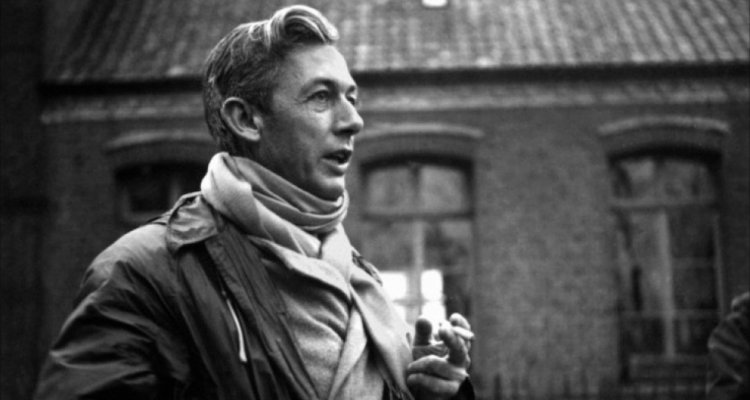 “A Man Escaped” (1956)
“A Man Escaped” (1956)
The profound effects of Bresson’s personal experiences during his 18 months in a German POW camp are deeply felt in what is arguably the apex of his catalogue, “A Man Escaped.” Based on the memoirs of André Devigny, who escaped from Fort Montluc in Lyon in 1943 during World War II, Bresson’s fourth feature is intense, breathlessly suspenseful and yet perhaps one of the quietest and most minimalist “thrillers” ever made. As naked and sparse as any of his films, on one side of the prison walls lie Nazi soldiers with their pistols, while on the other side sits a ravaged, gaunt soul of a man, with a burning will to survive. Told in the whispered hush of prisoners trying not to draw attention to themselves, the quietude in “A Man Escaped” is unnerving and in Bresson’s typically counter-intuitive manner, it ratchets up the tension inch by inch with silences, moments of intimate detail and the ever-present threat of being caught. Certain that his fate is execution, Lt. Fontaine (an unforgettable Francois Leterrier) aims to escape by any means necessary whether it means colluding with other would-be escapees, or building ingenious homemade tools out of stolen spoons. As in “Pickpocket,” Bresson is fascinated by the process, details and mechanics of escape, and while the film can be an almost excruciating study of incarceration, it is also an illuminating and deeply felt examination of the interior self. For all the talk of divinity and religion in his work, this deeply austere and claustrophobic portrait of a man seeking deliverance, truly exists in a state of grace, and is the holiest of Bresson experiences. [A+]
 “The Trial of Joan of Arc” (1962)
“The Trial of Joan of Arc” (1962)
One of Bresson’s shorter works, running at just 61 minutes, it is evident that with “The Trial of Joan of Arc” the director understood the power of economy and refused to pad out the story unnecessarily. It begins with Joan (Florence Delay) already captured and facing trial at the hands of the English judicial system for her part in leading the French troops to war against the English. During the trial the 19-year-old Joan reveals she acted on the insistence of the saints, with God Himself appearing before her in visions. Joan, attacked for everything from her clothing to her claims of virginity, is charged with witchcraft. However she sticks to her guns, even if it means being burnt alive. Similarly to Dreyer’s “The Passion of Joan of Arc,” Bresson’s “The Trial of Joan of Arc” relies on the source material of the historical transcript of Joan’s heresy trial. With classic Bressonian naturalism and low-key, neutral performances, the film has a restrained quality to it, stripped of every conceivable embellishment to the dialogue, sets and costumes. As he’d proven many times before, however, Bresson thrives in simplicity, and the monochromatic framing is controlled and precise, while his admiration and sympathy for Joan are clearly indicated throughout the film, making her victimization almost unbearable to watch. The film is performed with utmost fidelity to reality, with no overacting or contrived shots, and the transcripts are delivered almost word for word, bringing to sober life the solemn gravity of the trial. This even extends to its heroine; Delay looks small and weak in stature, neither the pseudo warrior Joan we are often given in pictures and films elsewhere, nor the ethereal Joan of Dreyer. Her strength, as far as Bresson is concerned, lies in the spirit of her convictions and her faith. [B]
 “Pickpocket” (1959)
“Pickpocket” (1959)
“An old thing becomes new if you detach it from what usually surrounds it,” Bresson once said, perhaps referring to this 1959 film. A cocky thief who flirts with apprehension by the authorities, the demure girl he’ll come to love and the patient cop waiting for the criminal to to make his one false move: all these are the classic ingredients of a crime film. But in Bresson’s hands, these traditional elements are anything but, and what transpires would border on a deconstruction of the form if such a thing interested the filmmaker at all. Loosely inspired by Dostoyevsky‘s “Crime and Punishment” and allegedly influenced by Sam Fuller’s “Pickup on South Street,” Bresson’s “Pickpocket” inspires almost religious zeal from its many ardent admirers. In his “Transcedental Style” tome on Bresson, Carl Theodor Dreyer and Yasujiro Ozu, director/screenwriter Paul Schrader (screenwriter of “Taxi Driver”) describes this unique portrait of the criminal mind, which he calls his most influential work, as an “unmitigated masterpiece.” A scant 75 minutes (many of his films were precise and to the point), and naturally, a tale of crime and redemption, “Pickpocket” centers on an arrogant young thief (Urguayan unknown Martin LaSalle) who becomes so enamored of and addicted to the art of pickpocketing that it becomes a compulsion he cannot stop, even though he knows he’s flirting with disaster. Almost silent (most of the dialogue is voiceover), and like the protagonist, almost entranced by the art of legerdemain, Bresson’s taut camera choreography is breathtaking; almost a zen-like study of sleight of hand. But while the sequences focusing on the mechanics of prestidigitation and the thrill of almost getting caught are deeply absorbing and grippingly tension-filled, the film is more than just well-crafted. Bresson plays his own emotionally aloof game of cat-and-mouse with the viewer, filling us with anxious dread right up until the explosion of unexpected emotion in the final, luminous climax of salvation. [B+]

